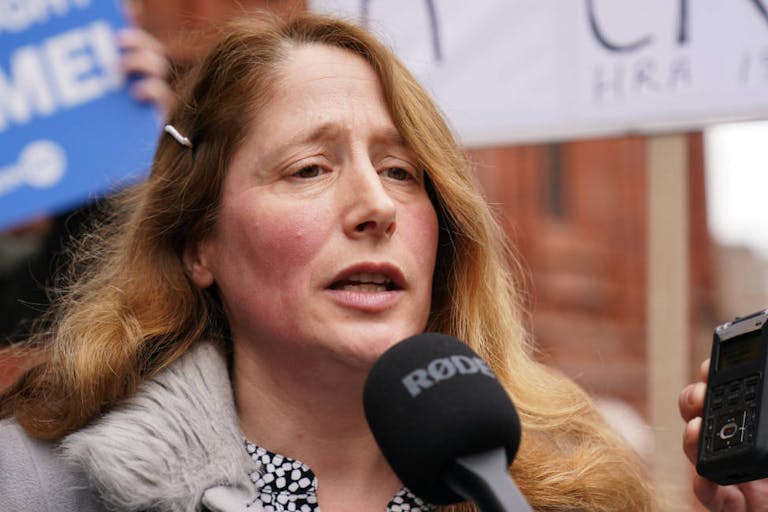
Pro-life activist first to be charged under UK's national abortion zone law
Angeline Tan
·
Fallacy of the Day: Frozen embryos in a burning building
Argue with enough pro-aborts, and you’ll get the distinct impression that (ideologically, at least) they lead fairly sheltered lives. Often their zest for the “right to choose” and contempt for those who oppose it doesn’t quite match their level of familiarity with their opponents’ arguments or the deficiencies of their own case. Because they’ve never been exposed to significant amounts of contrary thought and have only had their views reinforced rather than put through a genuine critical gauntlet, they develop a false sense of confidence in the sophistication and infallibility of their case.
I found this called to mind by a recent exchange with a particularly zealous commenter who, in what he seemed to think was an ingenious trump card, posed the following thought experiment:
Setup: House with two rooms. In the first room are (100) human embryos ready for implantation into women. In the second room are (2) six month old human born babies. The house is on fire. As a consequence, you only have enough time to enter one of the rooms and save its contents.
Question: Which room will you enter?
The idea is to trap the pro-lifer between two nauseating options. If we save the embryos, we seem like monsters for dooming infants (or children, or elderly people; there are a lot of variants out there) to a fiery death. If we pick the babies, we’re supposedly demonstrating that we don’t really see embryos as full people after all.
Thus, pro-aborts rub their hands together in glee, like a supervillain who’s certain that his ultimate death trap will finally vanquish his nemesis. However, also like a supervillain, their overconfidence has blinded them to the holes in their master plan.
For the record, the question actually isn’t new to pro-lifers. Not by a long shot. Personally, I was still in high school when it was first posed to me. We know that heart-string-tugging isn’t logical force, and we find the Burning Clinic Fallacy’s logic wanting.
First, note that it’s an appeal to personal intuition, not objective reason. It’s hinged on the questioner’s hope to stymie his opponent’s instincts, not his knowledge. Regardless of what one’s answer is, it does not change the empirically indisputable reality that an embryo is alive and human in every way that science defines individual life and membership in Club Homo sapiens. It introduces no information about biology. It offers no claim about natural-rights theory or insight into metaphysics. So even if the challenge were to expose something about the person doing the saving, it would demonstrate nothing about the people in need of saving.
Second, there is a tremendous logical gulf between the respect our rights deserve and our obligations in an emergency. The latter forces on us numerous circumstances and considerations with no implications for the former – particularly with the added qualifier that someone’s rescue must come at the expense of another’s. Further, in the scenario, we haven’t violated anyone’s rights – we didn’t start the fire that threatens their lives, and as the bodily autonomy absolutists are so fond of reminding us, there’s a principled difference between abstaining from harm and providing aid. Essentially, the Burning Clinic Fallacy confuses being a Good Samaritan with not being an aggressor.
Article continues below
Dear Reader,
In 2026, Live Action is heading straight where the battle is fiercest: college campuses.
We have a bold initiative to establish 100 Live Action campus chapters within the next year, and your partnership will make it a success!
Your support today will help train and equip young leaders, bring Live Action’s educational content into academic environments, host on-campus events and debates, and empower students to challenge the pro-abortion status quo with truth and compassion.
Invest in pro-life grassroots outreach and cultural formation with your DOUBLED year-end gift!
When events have crossed the rights bridge for us and forced us to find partial solutions to immediate harm, it’s legitimate to act on factors other than pure natural-rights theory to prevent as much suffering as we can. There could be any number of such reasons to choose the infants – the frozen embryos would likely die anyway when disposed of later, beyond our control; the infants would suffer horrible pain, and the embryos wouldn’t; or the infants’ deaths would massively traumatize their families.
(UPDATE, 4/20/13) It’s also worth noting that, as Melinda Penner does (via Scott Klusendorf), there could be reasons to make the opposite choice, too:
Now new variable could be introduced to the dilemma that change that survival calculation – a lab nearby could keep the embryos in their optimum condition, the baby has a terminal disease, etc. There are circumstances where I’d choose the embryos. But it’s that issue of survival that determines the choice, not that deep down I think one is really more valuable than the other one. So the dilemma just doesn’t prove anything.
Even so, it would not logically follow that the embryos have no right to life or that intentionally killing them would be just. The question here is which decision would cause the most suffering, not who has more rights. For the same reasons, one could legitimately choose to save an awake, pain-feeling patient over patients in comas or afflicted with congenital pain insensitivity: not because the former are more human or more valuable, but because they would suffer more. (End of Updated Section)
Indeed, we could make an endless list of such harrowing choices, none of which would legitimize murdering any of their participants. Let’s say one room is full of middle-aged strangers and the other holds your daughter. Or a young, healthy stranger vs. an old, terminally ill one. Or the president of the United States vs. Ken Lay. Or one of the most loaded examples imaginable, from Ramesh Ponnuru’s quintessential The Party of Death:
You can either rescue a research scientist who is making great strides toward a cure for Alzheimer’s disease, or rescue four heroin-addicted fifty-eight-year-old men who have spent their lives rotating through the penal system and are likely to continue to do so. Whom do you save?
Let’s say you save the scientist. Are you therefore saying that it’s permissible to kill hopeless old addicts? Are you saying that such people do not have the same right not to be killed that the scientist does?
Indeed, we don’t even have to hypothesize; the real world gives us far less convoluted examples. Doctors sometimes have to prioritize among the patients vying for their attention. Civilian casualties are sometimes unavoidable in warfare. President Harry Truman chose to devastate two Japanese cities, killing a minimum of 154,000 innocent people, because he deemed it the least bloody option in the long run. In January, we discussed the unique challenge facing “Auschwitz Abortionist” Gisella Perl.
But in every last one of these scenarios, from the IFV clinic to Hiroshima, the necessity of choosing anyone’s death is entirely the product of extreme circumstances. Take those away, and you’re left with no authorization to end anyone’s life.
The art of sophistry is to craft an argument that seems impressive, as long as it’s felt rather than analyzed. But like all superficial sleights of hand, all it takes is a little reason to bring it crashing down.
Live Action News is pro-life news and commentary from a pro-life perspective.
Contact editor@liveaction.org for questions, corrections, or if you are seeking permission to reprint any Live Action News content.
Guest Articles: To submit a guest article to Live Action News, email editor@liveaction.org with an attached Word document of 800-1000 words. Please also attach any photos relevant to your submission if applicable. If your submission is accepted for publication, you will be notified within three weeks. Guest articles are not compensated (see our Open License Agreement). Thank you for your interest in Live Action News!

Angeline Tan
·
Analysis
Cassy Cooke
·
Analysis
Nancy Flanders
·
International
Angeline Tan
·
Pop Culture
Cassy Cooke
·
International
Cassy Cooke
·
Guest Column
Calvin Freiburger
·
Abortion Pill Reversal
Calvin Freiburger
·
Guest Column
Calvin Freiburger
·
Abortion Pill Reversal
Calvin Freiburger
·
Activism
Calvin Freiburger
·